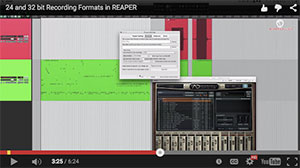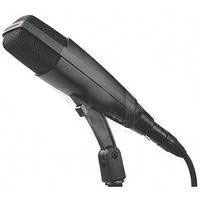 Yeah, the headline uses a “techie” sounding bit (ha!) of lingo, which I usually try to avoid. But sometimes you will run into these terms and it helps to know a little something about them.
Yeah, the headline uses a “techie” sounding bit (ha!) of lingo, which I usually try to avoid. But sometimes you will run into these terms and it helps to know a little something about them.
Bit depth in digital recording (using a computer or digital recorder rather than analog tape) refers to how many characters are used to represent the audio in digital language – you know, all that binary “ones-and-zeros” stuff. To get an idea what that even means, see my article: 16-Bit Audio Recording – What The Heck Does It Mean? where I tell you how “bit depth is like champagne”:-).
Anyway, the Reaper Blog recently published a video showing you why you might just want to stick to 24-bit recording and rendering, rather than thinking you can benefit from using something called “32-bit floating point.” You can see that video at the link below. But I wanted to say a few things about it before you check it out. The video not only explains what it promises in the title/headline, but in doing so, it shows you some other cool things as well. You’ll see what a “clipped” audio recording sounds like. That’s when you overloaded your interface and ended up with distorted audio. It looks squared off on the top. I always say that once you have distorted audio, you cannot “undistort” it just by turning it down. The damage has been done. You’ll see that in this video. You’ll also see a MIDI drum file in one of the tracks, along with the virtual instrument (Addictive Drums) that the MIDI is triggering.
So go and watch this short 6 minute video here. It’s full of great information: http://reaperblog.net/2015/02/video-24-and-32-bit-recording-formats-explained/
virtual drumming
More Virtual Drums For The iPad – Synth Drum Pads
There are several music-making apps for Apple iOS devices (iPads, iPhones, iPod Touch), and drum machines/virtual drum and percussion programs are certainly among them. I’ve written about a couple on this site:
MIDI Step Sequencer For iPad, which is about Nord Beat, a traditional type drum machine, and something that is sort of a virtual drum (and guitar) accessory for the iPad, Pix and Stix for iPad Garage Band App. These are actually drum sticks that you hit your iPad with. Crazy stuff, but may make drummers feel a bit more like they are playing drums.
Anyway, here is a new drum machine for the iPad only (not iPhone or iPod Touch) called Synth Drum Pads, from Paul Betowski. You can create all kinds of rhythm and melodic tones, which seem to be more suited toward the EDM (electronic dance music) genre, but certainly will find use in any music-making kit. Take a listen to an audio sample below:
Synth Drum Pads has 4 large pads, each with a set of parameters (tone, attack decay, etc.) above it that you set/tweak. The guide on the site shows you starting with a kick sound that is very similar to that in the popular TR-808. Note: there are no presets, so you’ll have to learn (or already know) a bit about drum programming. If you’ve used drums machines before, you should be OK.
But even if you have no experience, there are excellent instructions with pictures at the site here: http://designbypaul.co.uk/synthdrumpadshelp.html
Have fun!
Drum Kit Mic For Toms

I don’t have a real drum kit – though I have always wanted one (He’s whining. Ignore him). there has always been a female in my life to stop me owning my own kit. First it was my mom. Now it is my wife. She says if we ever get a house with a basement, I can have a drum kit. Shya. Anyway…
I mostly record small drums (bodhran, dumbek, tupan, tamborine, etc.) the “real” way, meaning with an actual microphone. If I want to record a rock or pop song, I use sampled drums, typically in the form of Storm Drum (what I used on my cover of My Eyes, from Dr. Horrible, and That Thing You Do, from The Movie of the same name, which you can check out here and here, respectively), Jamstix (what I used on my cover of You’re All I Have, by Snow Patrol, which you can hear and read all about here), and Drum Experience, which I will probably use for every virtual drum kit I ever use in the future (it’s THAT awesome – check it out here.
However, if you are fortunate enough to have real drums that you can record, here is a tutorial one recording just one of them, the tom. You typically mic each drum nowadays, and there is a different mic for each. For example it’s common to use a Shure SM81 on the snare, something like a Shure Beta 52 on the kick, and as in the following video, a Sennheiser MD421.
So here is the video – another form WinkSound. Enjoy!
Elektron Octatrack Video – Using It As A Drum Machine
Here is a video from YouTube user, sbookholt, that shows how to load single-hit drum samples into the amazing Octatrack, by Elektron, which is a hardware sampler and sequencer. In the video, he shows you how he was able to dispense with the other Elektron product, Machinedrum, which is another programmable sequencer/synthesizer, but specializing in drums (you might have guessed that by the name of the product:)). Both products are pricey ($1,240 and $990, respectively), so it one can truly do the job of two in yhour particular rig/gig purposes, then you can save hundreds of dollars.
See the tutorial video below:
Free Log Drum Sample Library Available For Kontakt
FluffyAudio has released a free sample library of log drum samples. This set comes with 258 samples, which should be plenty of variety to mix into your tracks. Even if you don’t use these samples very often, you really can’t beat that price. Listen to the demo track before you make any judgements.
You can get more information from the full article here: http://www.kvraudio.com/news/fluffyaudio-releases-my-log-drum-free-sample-library-for-kontakt-21805